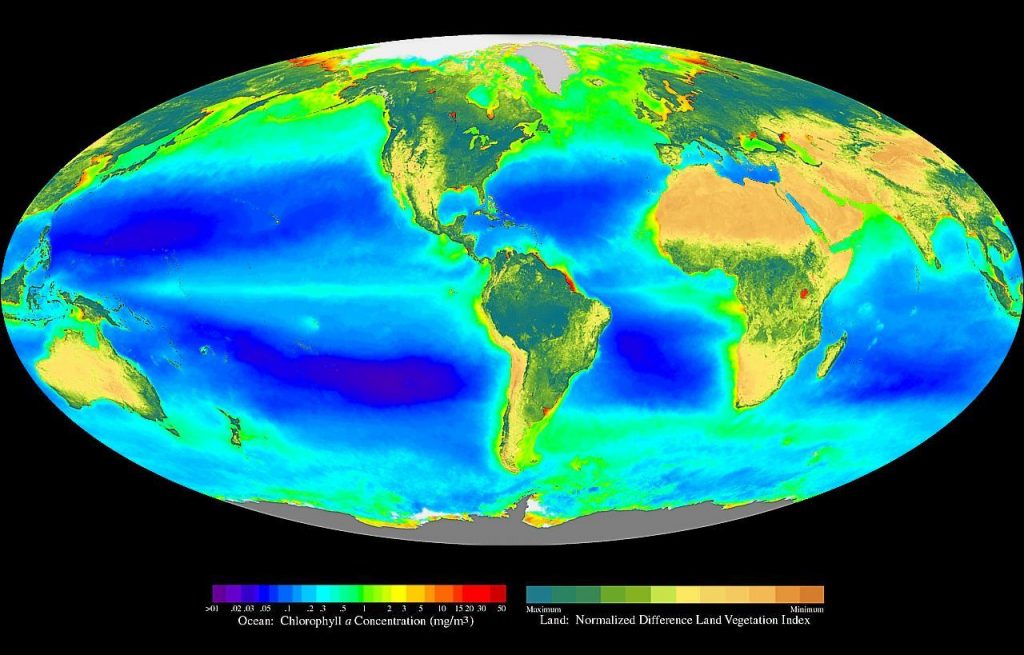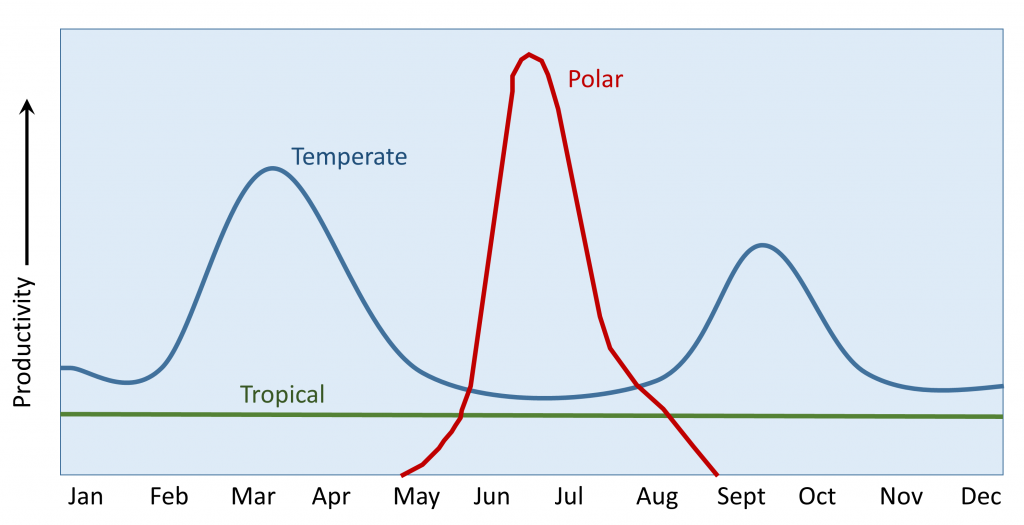Productivity In Polar Oceans Is
seven.iv Patterns of Primary Production
varies both geographically and seasonally. Geographically, affluence generally decreases every bit you lot move from littoral to oceanic waters (Effigy seven.iv.1). Coastal waters are more productive than the fundamental ocean for two main reasons. Showtime, from country ofttimes contains a loftier abundance of which get deposited in coastal waters and stimulate production. 2d, the shallower bottom along the can trap nutrients and prevent them from sinking to greater depths. Information technology is easier for these nutrients to be brought dorsum to the surface when they remain trapped in the shallows. Conversely, the key sea generally has very depression primary production, equally these areas are far removed from any terrestrial sources of nutrients, and the great depth prevents the deep nutrients from returning to the surface.
Global averages for ocean surface primary production are nigh 75-150 chiliad C/one thousandtwo/yr. Some highly productive areas include the California declension (200-300 g C/thoutwo/yr), the Southern Ocean (200-400 1000 C/mtwo/year), and the coast of Peru (200-400 g C/k2/twelvemonth), all regions with significant . The central ocean, by contrast, produces less than fifty g C/m2/year.

Regional and seasonal changes in primary production are due to a combination of the availability of light and the corporeality of nutrients provided past water mixing to a higher place the . In tropical regions sunlight is plentiful throughout the year, so light is non a limiting factor. The surface water is always warm and at that place is always a pronounced thermocline, leading to highly stratified water that prevents the nutrient-rich bottom water from reaching the surface (department half-dozen.2). Thus productivity in tropical water is always food-limited, and productivity is low throughout the year (Figure 7.four.2). Considering tropical h2o is nutrient-poor with trivial phytoplankton product, the water is very clear, as is the example with water in the key bounding main.
At the poles, the water is uniformly cold at all depths, so there is not much of a thermocline and trivial stratification, assuasive mixing to occur year-circular (section half dozen.ii). This mixing distributes nutrients throughout the h2o column, so that for much of the twelvemonth productivity will not be nutrient-limited. Notwithstanding, the polar regions may experience several months with little or no calorie-free during the winter, and the fluctuation in calorie-free levels leads to variation is seasonal productivity. In the winter months, mixing is occurring and nutrients are arable, only there is no light, then there is no productivity. By late spring the sunlight returns, and combined with the affluence of nutrients, a jump/summertime bloom of phytoplankton occurs (Figure 7.4.2). By late summertime, the nutrients accept been depleted and have been grazing on the phytoplankton, then the bloom begins to turn down. In the autumn, low-cal levels pass up and prevent further product throughout the wintertime. But during the winter the mixing is distributing nutrients throughout the water, ready for the sun to return and stimulate a bloom in the following summer.
In temperate regions in that location is much more than seasonal variation in the depth and intensity of the (run into section half dozen.two). The thermocline is shallower and stronger in the summertime, and is deeper and weaker in the wintertime, so mixing of deep and surface water is more than pronounced in the winter months. Every bit with the poles, this winter mixing creates food-rich water during the winter, but the lack of light limits wintertime productivity. When calorie-free levels increase in the spring, the combination of abundant light and nutrients creates a spring bloom of productivity. By belatedly summer at that place is still plenty of lite, but the nutrients take been depleted past the phytoplankton bloom, and the summer thermocline has prevented further mixing, and then productivity declines. In the autumn, cooler temperatures weaken the thermocline, and increasing storms cause a deeper to course, bringing nutrients back to the surface. At the same time, there is still sufficient light available that a smaller autumn bloom occurs (Figure seven.4.2). But this bloom is short-lived, every bit calorie-free declines throughout the autumn and into the winter. Over again, there is picayune production during the winter due to calorie-free limitations, but the winter storms and deep thermocline recharge the water with nutrients for the next leap blossom.

Productivity In Polar Oceans Is,
Source: https://rwu.pressbooks.pub/webboceanography/chapter/7-4-patterns-of-primary-production/
Posted by: padulaablumersy.blogspot.com


0 Response to "Productivity In Polar Oceans Is"
Post a Comment